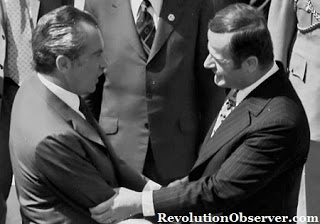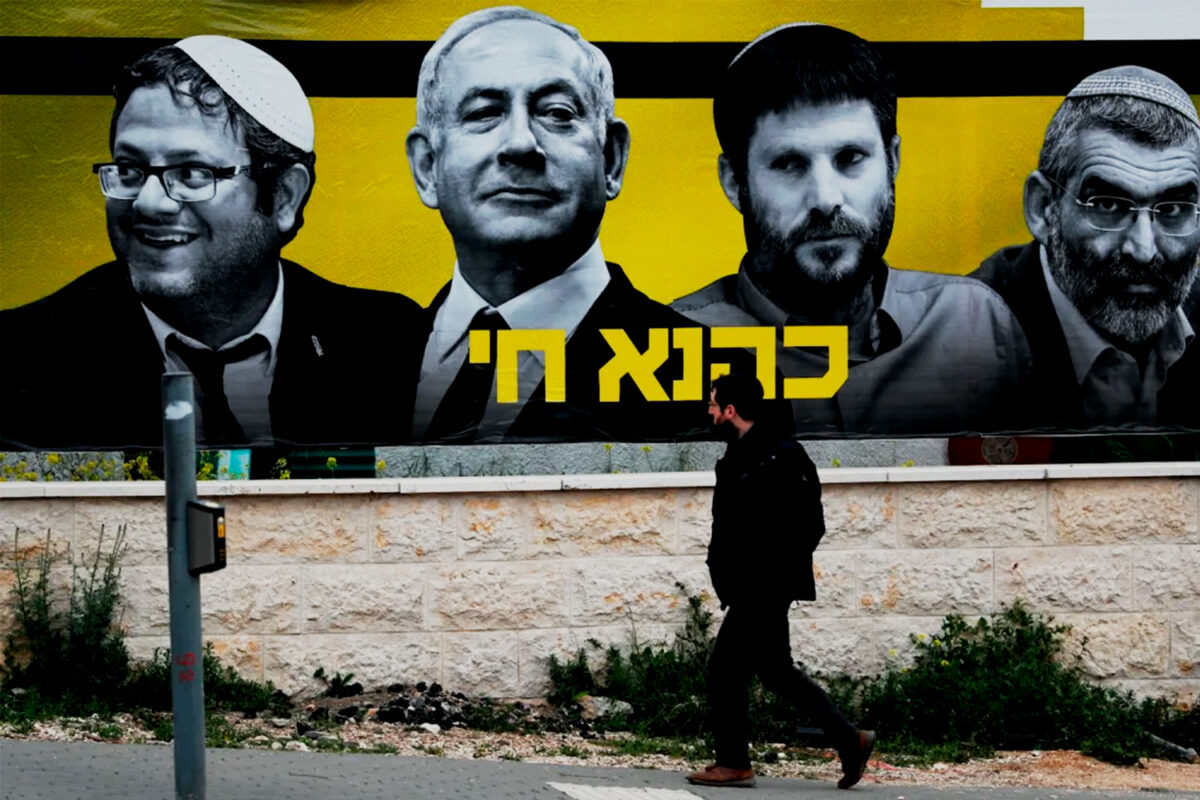 |
| President Nixon meeting Hafez Assad in 1974 |
By Abu Anas
After the defeat of the Ottoman Caliphate in World War I, and through the Sykes-Picot agreement between France and Britain in 1916, the French occupied what we know today as Syria. For one to understand the extent of US influence in Syria and to map the relationship between the Assad regime and the US, one must consider the history of modern Syria. The following are 10 key points, in chronological order, starting from the time of Western colonization of Syria to the present day, highlighting US involvement in the country.
-
US and CIA orchestrated military coups in Syria since 1949: The US, through its embassy in Damascus and the CIA, led the first ever military coup in Syria in 1949, as detailed in the book “The Game of Nations” by Miles Copeland. This marked the beginning of the international struggle over the Middle East between the United States, the new entrant to the world arena, and the Europeans (French and British) who held the influence in the region but came out of World War II devastated. The US embassy and the CIA continued to support several subsequent military coups in Syria throughout the 50s and 60s against their European rivals, this was an era of instability that lasted over two decades.
-
Hafez’s pullout out of the 1967 war to secure Israel: Ex-President, Amin al-Hafiz, said in an interview on Al-Jazeera on July 2nd, 2001 that Hafez al-Assad, the then Defense Minister, sent a strict order of withdrawal to the Syrian army from the Golan Heights at the beginning of the war. This was before any sign of defeat or real confrontation against the Israeli military which has resulted in the occupation of such a strategic location.[1] It was through this move, Assad gained the trust of the US in defending Israel’s northern border, which he continued to do for the next three decades.
-
US supporting Syria through UN Resolution 242 in 1967: UN Resolution 242 which was passed after the 1967 War, commonly known as the six-day war, with Israel and its occupation of the Golan Heights, grants Syria, to this day, the right to regain back its territory.[2] The US supported this agreement and Syria’s right to its territory. This is in stark contrast to the Israeli position, apart from occasional lip service, of rejecting any notion of surrendering this geographically strategic territory.
-
Strengthened US-Syrian relations after the 1973 war: After the 1973 surprise war with Israel, the US should have slammed Syria with sanctions. On the contrary, in 1974, President Nixon personally paid a visit to Damascus to strengthen relations with the Assad regime.
-
US acceptance of Syrian occupation of Lebanon since 1976: Syrian troops invaded Lebanon at the beginning of the civil war. The silence on part of the US against such an occupation was a “green light” to Hafez al-Assad to initiate and continue this invasion until 2005, when a French-mandated resolution pushed the Syrians out with American reluctance. One political analyst described this US role by saying: “[The US] seemed tacitly to acquiesce to continued Syrian ascendancy in Lebanon.”[3]
-
Cooperation of Syria and US through the Tai’f Agreement in 1989: The Ta’if agreement was signed in Saudi Arabia between the different Lebanese factions to put an end to the civil war in 89’. The US was the power broker besides France, Saudi Arabia, Egypt and Syria that helped form the agreement, “prompting international support for Syrian―guardianship over Lebanon.”[4]
-
Syria joining the US in its campaign to invade Iraq in 1991: Syria supported the US in its war campaign against Iraq (Operation Desert Storm) and sent 14,500 soldiers and personnel to aid the US in its invasion of Iraq.[5]
-
US mediating negotiation between Syria and Israel during 1990’s: Hafez al-Assad accepted the US to be a mediator between Syria and Israel. Army Chief of Staff, Lt. Gen. Hikmat al-Shihabi, led the delegation to the US that discussed peace negotiations on the matter. In an interview with Russia Today TV, Syrian ex-Minister of Defense and a pillar of the Assad regime, Mustafa Tlass, stated unequivocally that al-Shihabi was a CIA-agent for the US.[6]
-
Intelligence cooperation between CIA and Syria to torture detainees since 2001: The close cooperation between the CIA and the Syrian regime was so warm, that even during times when Syria was called a rogue state, the Syrian regime offered its services to do the dirty work of the CIA. The regime used its world renowned intelligence agencies to extract information from detainees and prisoners of war through torture for the CIA. The famous case of Canadian citizen Maher Arar is one example that made International news.[7]
- US support of regime during the Syrian Revolution of 2011: As has been discussed in detail through our first part of this series on the agency of the Assad regime, the US has stood silent and watched the daily slaughter of Syrian civilians for 2 years, in addition to denying the rebels the weapons needed to protect themselves and to oust Assad.
As can clearly be seen, the US tried early on in Syria’s modern history to set its agents in power through military coups. Although the US continued its public rhetoric against Syria, it achieved complete hegemony when its agent, Hafez al-Assad, gained power in 1970. Since al-Assad, Syria has been a covert proxy state for the US serving its interests in the region and protecting Israel’s northern borders, while outwardly claiming to be the resistance leader within the Arab region.
[1] http://www.aljazeera.net/programs/pages/fa527ac3-2308-4892-945e-7978486e3ac5 (arabic)





14 comments
Anonymous
18th December 2012 at 11:10 pm
Very good an interesting article, with sources and everything.
But is bashar al assad still an agent of the US now where the US have appointed a new puppet, Moaz al khatib as a alternative to bashar al assad?
I mean if bashar still was a puppet then he wouldnt keep fighting now where his masters has appointed a new man for his chair.
Revolution Observer
19th December 2012 at 2:38 am
Thanks for the question. The US is still preparing the new coalition to be able to rule Syria. Without having majority of the rebels under its authority, the coalition is a useless tool. The US can not afford yet to purge its old and expired agent Assad yet, so it is trying its best to elongate his survival. That can be seen through the tactics Assad is using, which are more defensive and avoiding direct confrontation so it can preserve itself as much and as long as possible. Best regards.
Anonymous
20th December 2012 at 2:00 pm
MashAllah…may Allah reward you.
I want to know that Asad has the support of US, but he is no more useful for her, Asad knows it that US now wants to eradicate him so why Asad is not reacting against it (US).
or Asad feels in a way that his time has come to an end however, US can open some options like safe-exit,political asylum for him……
Jzk Khr..
Revolution Observer
20th December 2012 at 5:10 pm
Thank you for your Question.
You are correct, Assad is under the mercy of the US to save him through some sort of exit.
Anonymous
27th August 2013 at 9:23 am
very nice and great article sir. I guess it is an easy way for US to make its position strong in the middle east if it enters Syria. more over US is surrounding IRAN in this way…
Revolution Observer
31st August 2013 at 7:09 pm
True, and as a matter of fact Iran and US have matching interests in Syria and Middle East in general. As you can see the US has not condemned Iran’s support of Assad, neither the invasion of Hezbollah into Syrian soil! In fact Iran has the upper hand in Iraq and the US seems to be content packing and leaving “Iran” with such an important country that has wealth and geography that gives Iran more strategic depth within the Middle East.
Glor Moslamach
31st August 2013 at 1:41 pm
MashaAllah… A brilliant analysis!!! May Allah give such insight to many in the Ummah Ameen…
Revolution Observer
31st August 2013 at 7:11 pm
May Allah bless you too!
Mizan Beg
14th September 2013 at 11:31 am
Brother I have read somewhere that One of the pm of israel also praised Hafiz after the war. Can you provide me link for this ?
Anonymous
9th December 2013 at 12:12 am
Brother, is there a reason why the coup of 1970/71 which put Hafez into power is not on the list?
Revolution Observer
9th December 2013 at 6:41 pm
Wa alaikum assalam Brother. 2 reasons:
1) It is listed implicitly under point #1
2) Since we are trying to prove Hafez’s agency, one would concentrate on bringing facts aside from his own coup to support that view.
wassalamu alaikum!
Pingback: Perang Amerika—Perancis di Suriah | Hizbut Tahrir Indonesia
Pingback: Peran Amerika—Perancis di Suriah – Visi Muslim News
AbuP
23rd August 2021 at 12:39 am
Can you send me the article of the First Part concerning the 2011 uprisings – it is not available anymore